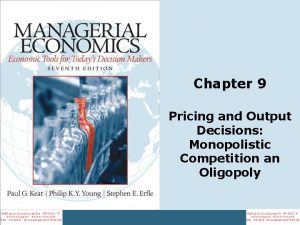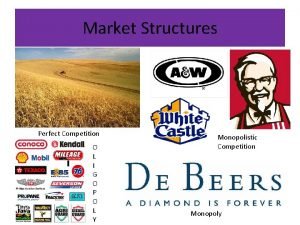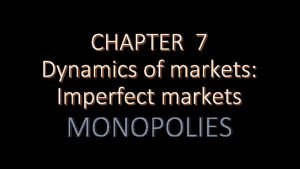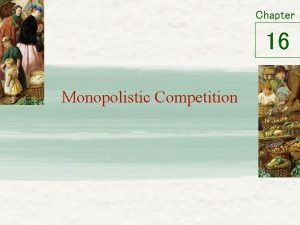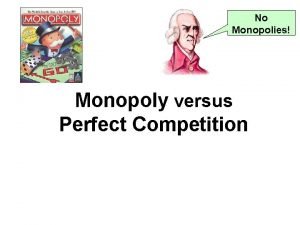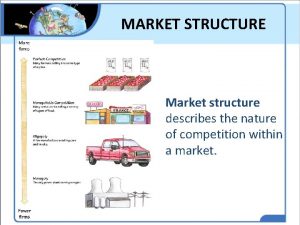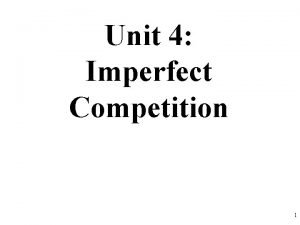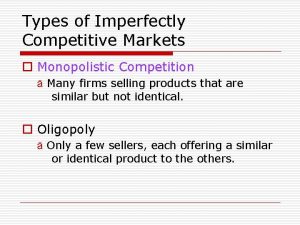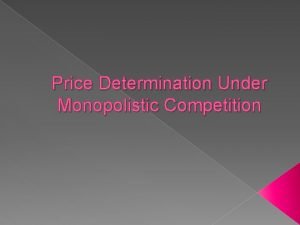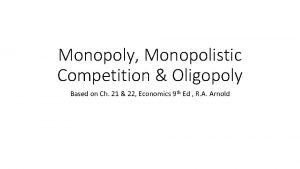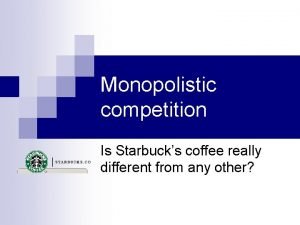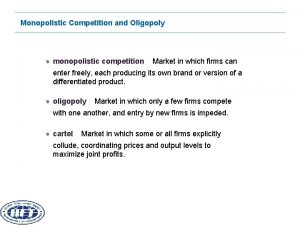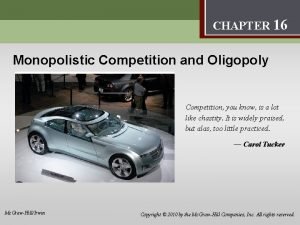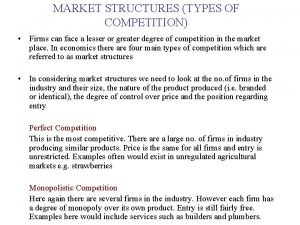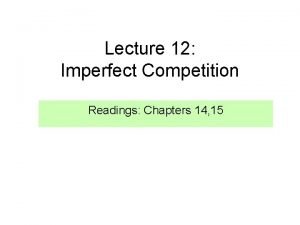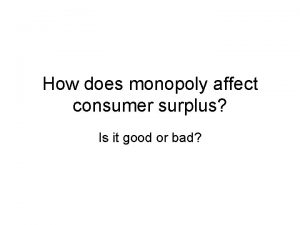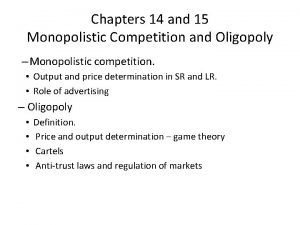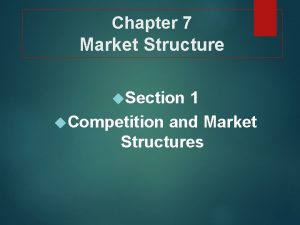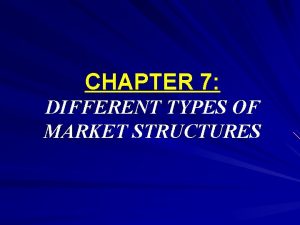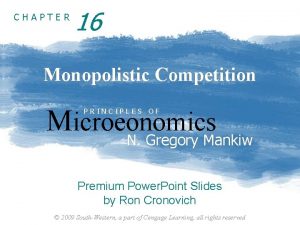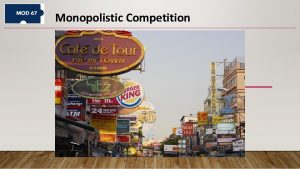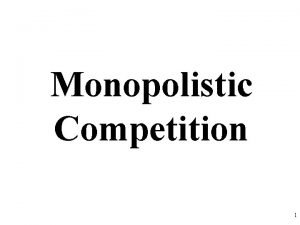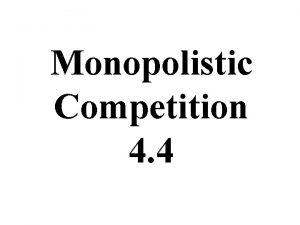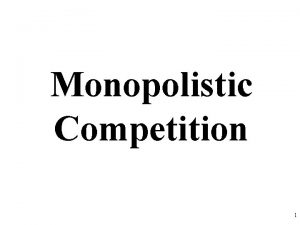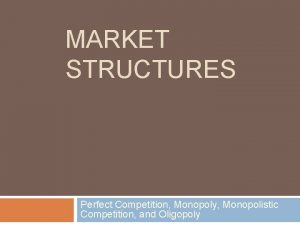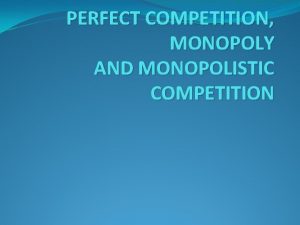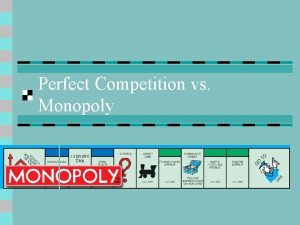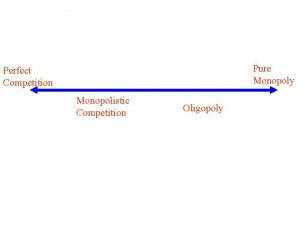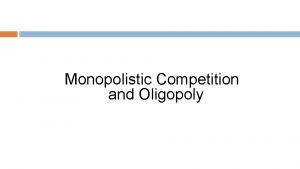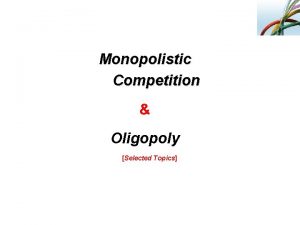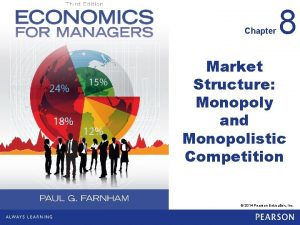Market Structure Perfect Competition Monopoly and Monopolistic Competition




























- Slides: 28

Market Structure: Perfect Competition, Monopoly and Monopolistic Competition

Perfect Competition Monopolistic Competition Oligopoly Monopoly Less Competitive More Competitive Market Structure

Perfect Competition Many buyers and sellers Buyers and sellers are price takers Product is homogeneous Perfect mobility of resources Economic agents have perfect knowledge • Example: Stock Market • • •

Monopolistic Competition • • Many sellers and buyers Differentiated product Perfect mobility of resources Example: Fast-food outlets

Oligopoly • Few sellers and many buyers • Product may be homogeneous or differentiated • Barriers to resource mobility • Example: Automobile manufacturers

Monopoly • Single seller and many buyers • No close substitutes for product • Significant barriers to resource mobility – Control of an essential input – Patents or copyrights – Economies of scale: Natural monopoly – Government franchise: Post office

Perfect Competition: Price Determination

Perfect Competition: Price Determination

Perfect Competition: Short-Run Equilibrium Firm’s Demand Curve = Market Price = Marginal Revenue Firm’s Supply Curve = Marginal Cost where Marginal Cost > Average Variable Cost

Perfect Competition: Short-Run Equilibrium

Perfect Competition: Long-Run Equilibrium Quantity is set by the firm so that short-run: Price = Marginal Cost = Average Total Cost At the same quantity, long-run: Price = Marginal Cost = Average Cost Economic Profit = 0

Perfect Competition: Long-Run Equilibrium

Competition in the Global Economy Domestic Supply World Supply Domestic Demand

Competition in the Global Economy • Foreign Exchange Rate – Price of a foreign currency in terms of the domestic currency • Depreciation of the Domestic Currency – Increase in the price of a foreign currency relative to the domestic currency • Appreciation of the Domestic Currency – Decrease in the price of a foreign currency relative to the domestic currency

Competition in the Global Economy /€ R = Exchange Rate = Dollar Price of Euros € € Supply of Euros Demand for Euros €

Monopoly • Single seller that produces a product with no close substitutes • Sources of Monopoly – Control of an essential input to a product – Patents or copyrights – Economies of scale: Natural monopoly – Government franchise: Post office

Monopoly Short-Run Equilibrium • Demand curve for the firm is the market demand curve • Firm produces a quantity (Q*) where marginal revenue (MR) is equal to marginal cost (MR) • Exception: Q* = 0 if average variable cost (AVC) is above the demand curve at all levels of output

Monopoly Short-Run Equilibrium Q* = 500 P* = $11

Monopoly Long-Run Equilibrium Q* = 700 P* = $9

Social Cost of Monopoly

Monopolistic Competition • Many sellers of differentiated (similar but not identical) products • Limited monopoly power • Downward-sloping demand curve • Increase in market share by competitors causes decrease in demand for the firm’s product

Monopolistic Competition Short-Run Equilibrium

Monopolistic Competition Long-Run Equilibrium Profit = 0

Monopolistic Competition Long-Run Equilibrium Cost with selling expenses Cost without selling expenses

Oligopoly • • • Few sellers of a product Nonprice competition Barriers to entry Duopoly - Two sellers Pure oligopoly - Homogeneous product Differentiated oligopoly - Differentiated product

Sources of Oligopoly • • Economies of scale Large capital investment required Patented production processes Brand loyalty Control of a raw material or resource Government franchise Limit pricing

Kinked Demand Curve Model • Proposed by Paul Sweezy • If an oligopolist raises price, other firms will not follow, so demand will be elastic • If an oligopolist lowers price, other firms will follow, so demand will be inelastic • Implication is that demand curve will be kinked, MR will have a discontinuity, and oligopolists will not change price when marginal cost changes

Kinked Demand Curve Model
 Lump sum subsidy
Lump sum subsidy Monopoly vs monopolistic competition
Monopoly vs monopolistic competition Competition refers to
Competition refers to Difference between monopoly and monopolistic competition
Difference between monopoly and monopolistic competition Difference between monopoly and monopolistic competition
Difference between monopoly and monopolistic competition Difference between monopolistic competition and oligopoly
Difference between monopolistic competition and oligopoly Dynamics of imperfect market
Dynamics of imperfect market Difference between perfect competition and monopoly
Difference between perfect competition and monopoly Market structure venn diagram
Market structure venn diagram P = mc
P = mc Difference between perfect competition and monopoly
Difference between perfect competition and monopoly Market structure describes
Market structure describes Chapter 7 section 3 monopolistic competition and oligopoly
Chapter 7 section 3 monopolistic competition and oligopoly Characteristics of monopoly
Characteristics of monopoly Excess capacity graph
Excess capacity graph Monopolistic competition products examples
Monopolistic competition products examples Price output determination under monopolistic competition
Price output determination under monopolistic competition Consumer surplus in monopolistic competition
Consumer surplus in monopolistic competition Starbucks perfect competition
Starbucks perfect competition Monopolistic competition price
Monopolistic competition price Oligopoly characteristics
Oligopoly characteristics Advantage of monopolistic competition
Advantage of monopolistic competition Monopolistic competition in long run
Monopolistic competition in long run Monopolistic competition short run
Monopolistic competition short run How does monopoly affect consumer surplus
How does monopoly affect consumer surplus Examples of oligopoly competition
Examples of oligopoly competition Chapter 7 lesson 1 competition and market structures
Chapter 7 lesson 1 competition and market structures Monopolistic competition examples
Monopolistic competition examples Monopolistic competition characteristics
Monopolistic competition characteristics




